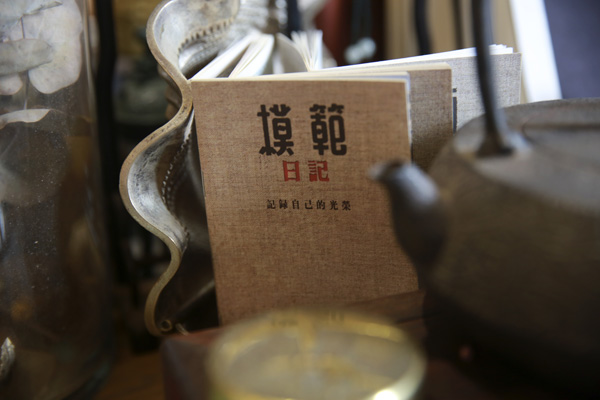Chips off the old block
Updated: 2016-08-20 07:32
By Xing Yi(China Daily)
|
||||||||
 |
|
Notebooks designed by Mofan bookstore. [Photo by Feng Yongbin/China Daily] |
Jiang has collected more than 30,000 woodblocks, about one tenth of which date back to the Ming Dynasty (AD 1368-1644), which means he may have the largest woodblock collection of any individual in China.
Between 2009 and 2012 a few of his prints were on display in a branch of the National Library in Wenjin Street, Beijing, the only one of its kind in the capital.
"In a sense, woodblocks are progenitors of the book," says Jiang, who is also renowned in China as a book designer. "All my works are associated with books."
In late 2014 when the Nobel Museum in Stockholm invited him to design a book for the 2012 Nobel Prize for Literature laureate Mo Yan to present in its exhibition, Jiang decided there was no better way of interpreting Mo than through a traditional Chinese thread-bound book printed using woodblock.
The book is a short story called Gale that Mo chose from his early works that has about 4,000 characters, and Jiang decided to use a font from Caochuang Yunyu, a poetry anthology by the poet Zhou Min in the Song Dynasty (960-1279), for the book.
Jiang says it took him three months to choose the matching characters from Zhou's poems and piece them together for Mo's short story.
Then he needed to prepare the woodblocks for printing, a process in which wood is carved away, leaving the characters to stand out as a relief pattern for inking and printing.
"The process is difficult because it is such a rare font," says Zhao Yishen, 30, who carved pages one to six of Mo's book. "It's like calligraphy, with many elements of handwriting."
Zhao says that with most printing fonts he can carve about 30 or 40 characters a day, but with the font for the Mo book the number was halved.
"As carvers we aimed to make the characters look as natural as the original writing, not too stiff."
With five other carvers, Zhao worked on the book each day for three months from 8 am to 6 pm.
"It needed the utmost concentration. I took breaks whenever my eyes got sore, and whenever I began to lose focus I stopped to avoid making mistakes."
- International trade corridor tested
- Netizens go crazy for beautiful young doctor who helps woman give birth in shopping mall
- Organ harvesting rumors slammed
- Beijing to try out 5G in key areas by 2020
- Nation's next generation of missiles to be highly flexible
- Li urges top advisers to rely on broad vision
- Malaysian authorities say ship carrying diesel hijacked
- Army commander: THAAD would 'easily affect' China-US ties
- Twin panda cubs confirmed born in Vienna zoo
- Four killed in boat collision in Greece
- Premier Li to receive Aung San Suu Kyi
- S Korean president names 3 new ministers for partial reshuffle

 Top 10 cities with highest GDP in H1
Top 10 cities with highest GDP in H1
 Chinese teenagers take gold, silver on 10m platform
Chinese teenagers take gold, silver on 10m platform
 US granted re-run to send China out of relay race
US granted re-run to send China out of relay race
 China inches toward gold after beating Netherlands
China inches toward gold after beating Netherlands
 Premier Li welcomes Aung San Suu Kyi
Premier Li welcomes Aung San Suu Kyi
 Zhao wins China's first gold medal in men's taekwondo
Zhao wins China's first gold medal in men's taekwondo
 World's top 10 innovative economies
World's top 10 innovative economies
 Dancing, food and religion, all in a Xinjiang wedding
Dancing, food and religion, all in a Xinjiang wedding
Most Viewed
Editor's Picks

|

|

|

|

|

|
Today's Top News
Trump outlines anti-terror plan, proposing extreme vetting for immigrants
Phelps puts spotlight on cupping
US launches airstrikes against IS targets in Libya's Sirte
Ministry slams US-Korean THAAD deployment
Two police officers shot at protest in Dallas
Abe's blame game reveals his policies failing to get results
Ending wildlife trafficking must be policy priority in Asia
Effects of supply-side reform take time to be seen
US Weekly

|

|







